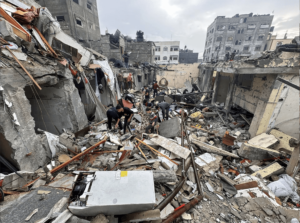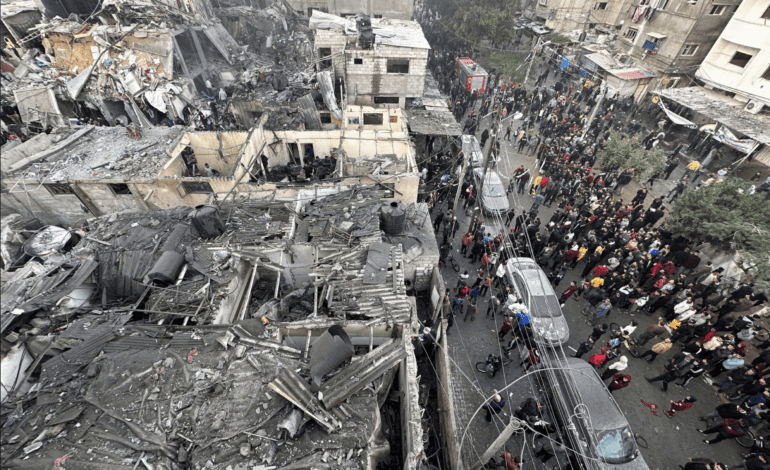On Wednesday, Israel announced its worst combat losses in more than a month after an ambush in the ruins of Gaza, and faced growing diplomatic and international isolation as civilian deaths mounted and a humanitarian catastrophe worsened in the Palestinian territory.
Intense fighting between Hamas fighters and Israeli soldiers was under way in both north and south Gaza, a day after the United Nations demanded an immediate humanitarian ceasefire and President Biden said Israel’s “indiscriminate” bombing of civilians was costing international support.
Israeli Prime Minister Benjamin Netanyahu said the military would fight on despite international pressure for a ceasefire.
“We’re continuing until the end, until victory, until Hamas is annihilated,” he told soldiers in Gaza over radio. “I say this in the face of great pain, but also in the face of international pressures. Nothing will stop us.”
Israel reported 10 of its soldiers killed in 24 hours, including a full colonel commanding a forward base and a lieutenant colonel commanding a regiment. It was the worst one-day loss since 15 soldiers were killed on Oct. 31.
Most of the deaths came in the Shejaia district of Gaza City in the north, where troops were ambushed trying to rescue another group of soldiers who had attacked Hamas fighters in a building, the military said.
Hamas said the episode showed that Israeli forces could never subdue Gaza.
“The longer you stay there, the greater the bill of your deaths and losses will be, and you will emerge from it carrying the tail of disappointment and loss, God willing.”

Palestinians inspect the site of Israeli strikes on houses, amid the ongoing conflict between Israel and the Palestinian Islamist group Hamas, in Rafah, in the southern Gaza Strip, December 13. – Photo by Reuters
In a televised address, Hamas Chief Ismail Haniyeh said any future arrangement in Gaza without Hamas was a “delusion.”
Israel had global sympathy when it began a campaign to “annihilate Hamas”, the group whose fighters stormed across the border fence from Gaza on Oct. 7, killing 1,200 Israelis, mostly civilians, and seizing 240 hostages, according to the Israeli authorities.
But since then, Israel has brutally attacked the Palestinian enclave and laid much of it to waste. Gaza’s health ministry said on Wednesday at least 18,608 people have been killed and 50,594 injured in Israeli strikes on Gaza. Many thousands more are feared lost in the rubble or beyond the reach of ambulances.
At least 288 displaced people in shelters run by the U.N. Palestinian refugee agency have been killed in Gaza since Oct. 7, the agency said in a post on X on Wednesday.
Warplanes again bombed the length of Gaza and aid officials said the arrival of winter rain worsened conditions for hundreds of thousands sleeping rough in makeshift tents. The vast majority of Gaza’s 2.3 million people have been made homeless.
In Rafah, in Gaza’s south, the bodies of a family killed in an air strike were laid out in the rain in bloodied white shrouds, including several small children. One, the size of a newborn, was wrapped in a pink blanket.
Ahmed Abu Reyash collected the bodies of his nieces, aged 5 and 7. As he walked through the street carrying one of the girls, a relative tugged at the shroud and shouted, “These are children! Children! Do they kill anyone other than children? No! These are innocents! They killed them with their dirty hands!”
At a tent camp in Rafah, Yasmin Mhani said she had woken up at night to find her youngest child, who is 7-months-old, soaking wet.
“This is the fifth place we have had to move to, fleeing from one place to another, with nothing but a t-shirt on,” she said, hanging wet clothes outside her tent.
Since a week-long truce collapsed at the start of December, Israeli forces have extended their ground campaign from the northern Gaza Strip into the south with the storming of the main southern city of Khan Younis.

Displaced Palestinians, who fled their houses due to Israeli strikes, walk following heavy rains at tent camps, as the conflict between Israel and Hamas continues, in Rafah, in the southern Gaza Strip, December 13. – Photo by Reuters
Meanwhile, fighting has only intensified amid the rubble of the north, where Israel had previously said its military objectives had been largely met.
The scars of Israel’s ground assault could be seen in a cemetery in the Al-Faluja neighborhood of Jabalia, northern Gaza. Tanks had churned up the ground, breaking and scattering gravestones and disinterring some corpses.
In the south, Israeli forces advanced in recent days to the center of Khan Younis, and on Wednesday were using bulldozers to destroy a road near the home of the Hamas leader in Gaza, Yahya Sinwar, resident Abu Abdallah told Reuters.
In central Rafah in the southern Gaza Strip, Palestinian health officials said 13 people were killed in an Israeli strike that hit two houses.
Hospitals in the north have largely stopped functioning. In the south, they have been overrun by the dead and wounded, carried in by the dozen throughout the day and night.
“Doctors, including myself, are stepping over the bodies of children to treat children who will die,” Dr. Chris Hook, a British physician with medical charity MSF at Nasser hospital in Khan Younis, told Reuters.
Israel says it has been encouraging increased aid to Gaza through Egypt’s border, and is announcing daily four-hour pauses in operations near Rafah to help civilians reach it. The U.N. says cumbersome inspections and insecurity limit aid flows.
Israeli designated safe zones “quite simply not safe”
At an Israeli occupation forces press briefing, spokesperson Keren Hajioff said their forces were taking several measures to prevent civilian casualties.
She said such measures included encouraging civilians to “temporarily” move out of the line of fire, which now extends across most of Gaza. But a UNICEF spokesman told CBS News on Wednesday that Gaza’s so-called safe zones are “quite simply not safe.”
White House national security spokesperson John Kirby told reporters that national security adviser Jake Sullivan, who is visiting the region, would discuss with the Israelis the need to be more precise with their strikes against Hamas targets.
Sullivan met with officials of Saudi Arabia on Wednesday and discussed “broader diplomatic efforts to maintain stability across the region and prevent the Israeli war on Gaza from expanding,” a U.S. official said.

A screen shows the voting results during the meeting of the United Nations General Assembly on a ceasefire resolution, amid the ongoing conflict between Israel and the Palestinian Islamist group Hamas, in New York City, U.S., December 12. – Photo by Reuters
U.N. General Assembly votes overwhelmingly to demand a humanitarian ceasefire in Gaza
On Tuesday, the U.N. General Assembly voted overwhelmingly to demand a humanitarian cease-fire in Gaza in a strong demonstration of global support for ending the Israeli war on Gaza. The vote also showed the growing isolation of the United States and Israel.
The vote in the 193-member world body was 153 in favor, 10 against and 23 abstentions, and ambassadors and other diplomats burst into applause as the final numbers were displayed. The United States and Israel were joined in opposing the resolution by eight countries — Austria, Czechia, Guatemala, Liberia, Micronesia, Nauru, Papua New Guinea and Paraguay.
The support was much higher than for an Oct. 27 Arab-sponsored resolution that called for a “humanitarian truce” leading to a cessation of hostilities, where the vote was 120-14 with 45 abstentions.
“Today was a historic day in terms of the powerful message that was sent from the General Assembly,” Riyad Mansour, the Palestinian U.N. ambassador, said after the vote. “And it is our collective duty to continue in this path until we see an end to this aggression against our people, to see this war stopping against our people. It is our duty to save lives.”
The United States has grown increasingly isolated in its support for Israel’s military campaign in Gaza.
— Reuters, AP. Edited by The Arab American News staff for style and content.






Leave a Reply